Text
Conclusion: Thanks for Stopping By!

As my blog posts come to an end, it is with my sincere hope that you have learned something new within the realm of audience studies. It is my duty to remind my readers that studying the audience is an ongoing approach with new studies and sociological and psychological suggestions towards audience behaviour continuing to be published.
Audience Studies in a New Century

Sullivan outlines the challenges for scholars who wish to study media audiences in the 21st century. The notions of agency and structure can inform our understanding of audiences in an Internet age. We recognize the small, unmediated audiences are rarer in world of mass-produced content. Even in medieval ages, mass audiences had begun to be introduced with playwrights rising in popularity, though not to the scale of digitalized audiences. The term “audience” is debated, and whether or not the people in question must be in close proximity to fall under the definition, or do individuals sitting at home participating in online culture also form a collective agency?
The New Economics of Audience Aggregation

Sullivan states that with the expansion of media texts and technological platforms, audience independence is at a greater number than ever before in the 21st century. Sullivan suggests that evidence proves that media producers and distributors have begun to effectively adapt to the shifts in our media consumption habits. Today, audiences focus their attention on popular media products or hit programs, but viewer attention is still spread out across a group of smaller, niche, content options. With the growing popularity of video streaming services such as Hulu, Netflix, Crave and Disney+, audience members are provided with instant content that is catered to both wide groups and selective groups delving into the suggested titles.
What is my Role as an Audience Member?

I like to think of myself as an equal part consumer and producer of media content. I am a viewer, a reader, a writer, a learner, a fan and a critic. Though I have grown up in a digitalized era, I still make room for the “traditional” media prints. I read books, I listen to live music and I venture out to the movies. I use the internet for many of my personal satisfaction needs, I binge Netflix programs, I watch YouTube videos, I read AND write Fanfiction and I leave reviews on the stuff I love and the stuff I hate. I am an active audience member every day when as soon as I wake up. I listen to the radio while driving to school, I sit in on lectures and seminars where important material is being discussed, and I participate in recreational activities and leisure when I go home at night and log onto Reddit to catch up on current events and socialize with those who have similar interests to mine.
As an audience member, I am aware that I am equal parts an object, agent and outcome.

Sources
Sullivan, J. (2013). Media Audiences: Effects, users, institutions and power. (1st ed.). Sage Publications Inc., New York, NY.
0 notes
Text
Media Production: How Audience Engagement Saved a Life

In John L. Sullivan’s discussion on online interactive audiences in a digital media world, he states how audiences have the power of modern computers to create, remix, and distribute their own media via the internet. Audiences have become accustomed to high levels of interactivity online. He defines traditional one-way media forms as television, radio and film and states that they are beginning to lose their allure. Audiences want to be engaged, informed, entertained and even outraged by today’s media. The quality of certain sites depends entirely on the collective contributions of audience members.
This being said, how we would function in a digital world without contributions from fellow participants? As Sullivan states, the surplus of audience activity has enabled internet users to accomplish tasks that would “prove daunting for each individual alone.” Collectively, however, “knowledgeable, talented, yet geographically dispersed individuals can pool their resources in real time to create media and solve problems quickly and effectively.

Reddit Case Study
In 2015, a Reddit user known only by his username, RBradbury1920 posted to the “legal advice” subreddit with a mystery on his hands. He described how in April of the same year, he found a yellow post-it note in unfamiliar handwriting on his desk. He ignored the first note and wrote it off as being overtired and simply not remembering he wrote it, despite the handwriting being odd. Over the course of a month he kept finding post-it notes around his apartment with simple reminders for his everyday activities, such as to save the documents on his computer. He ultimately became concerned when one post-it note was found saying “our landlord isn’t letting me talk to you, but it’s important we do.” He checked the webcam footage he had set up in case of a break in, but found the files had been deleted. He opened up to the members of the legal advice forum to help assist him in finding his best route of option, should he contact the landlord directly, or involve the police?
However, despite the odd findings around his apartment, it turns out RBradbury1920 should not have been following legal advice, and would have been better off suited in seeking medical advice. Another user, Kakkerlak, contributed a solution to the problem. He announced that though it was entirely possible that the landlord was leaving notes, it seemed extremely unlikely. What would be the landlord’s motivation for this act? Kakkerlak suggested that there could be a underlying medical issue causing the man to be writing notes to himself and somehow forgetting. Kakkerlak suggested two possible options: either he had a mental health issue such as dissociation, or it could be a physical problem caused by ventilation issues within the apartment. This user instructed the original poster to purchase a carbon monoxide detector.
Shortly after this suggestion was made, RBradbury1920 decided to invest in a CO detector and was shocked to find out it read at 100 ppm, meaning that for every 999,900 molecules of air there are 100 molecules of CO, a dangerous number that leads to headaches, dizziness and apparently, forgetfulness after only a couple hours of exposure. So, quite literally, the anonymous Reddit user, Kakkerlak saved the man’s life with his quick-thinking and audience participation.

What does this mean to us?
As Sullivan suggests, audience activity online is beneficial in establishing the quality of certain internet-based groups. How would a community like Reddit thrive without user engagement? It would be a very bleak and dull website, as the very notion of the website is based on a question-and-answer format. Sullivan also mentions YouTube in the text, and how its success also arises from audience submissions. Users are encouraged to upload and watch videos, comment on the content, and share it with other individuals. YouTube would not have the success it does today if audience members were not encouraged to take part in the streaming platform. While sites such as Reddit and YouTube would prove daunting for individuals alone, the talent and knowledge coming from a plethora of users helps value the site as a social engagement platform.
Sources
Sullivan, J. (2013). Media Audiences: Effects, users, institutions and power. (1st ed.). Sage Publications Inc., New York, NY.
0 notes
Text
Fanfiction: How it Came to Be

Among the realms of internet-based fans come sites where they are able to express their ideas and unravel the many thoughts pertaining to the fandoms they hold dear. As Sullivan states, fans are distinguished from the rest of the audience through their intense interest and dedication to specific popular media. Fans exhaust much of their energy into these realms, both online and in person, becoming an entire subgroup of audience through their dire enthusiasm of the texts they enjoy: music, film, television and sports. Sullivan makes note of how fans stem beyond the definition of “passive consumers”, as they have taken a step beyond the act of simply tuning in to the texts they enjoy so much (Sullivan, 206). The active fans delve into activities beyond basic viewership, where they become producers of the texts they become intrigued with. Fans may produce artwork, poems, songs, video edits and attend both local and distant social gatherings with other fans. What will be dissected in this particular blog post is the growth of FanFiction, the humble beginnings, where the term was coined and what was the “first” Fanfiction.

Humble Beginnings
Though popular FanFiction websites such as Fanfiction.net had not come into existence until the late 1990’s, the activity itself had been around for decades longer. Fanfiction is described as amateur narrative writing based on already-existent texts such as novels, movies, television series and real life celebrities or public figures. Journalist Laura Miller in a piece published by New York Magazine described the development of FanFiction,
"...fanfiction as we now know it began back in the days of Star Trek fanzines, on whose mimeographed pages female Trekkers wrote of Mr. Spock swooning in the arms of an ardent Captain Kirk. For decades, fanfiction communities – soon to migrate en masse to the web – functioned as a subset of science-fiction and fantasy fandom, where they were treated, by the mostly male nerds who ran things, like a younger sister best banished to her room whenever company came by. The internet changed all that by ushering in the era of the networked fan, often a girl who sampled her first taste of fic in Harry Potter fandom." (Miller, 2015)

Origin of the Term
The term Fanfiction was coined in 1939 by the sci-fi community as a derogatory term differentiating the amateur written stories and the professional ones. In the 1944 Lexiconic fandom handbook, Fancyclopedia, edited by John Bristol Speer, the definition of Fanfiction was cited as:
“[sometimes] improperly used to mean fan science fiction, that is, ordinary fantasy published in a fan magazine... occasionally bringing in some famous characters stf [science fiction] stories. [...] Fictitious elements are often interspersed in account of fan activities, which may make them more interesting, but plays hob with a truth-seeker like [Greek philosopher] Thukydides. Round robins have been attempted in the fan fiction field.”

Star Trek And Slash Fiction
This definition remained from 1930-1950, until the first modernized fanfiction was introduced in the form of a Star Trek fanwork. Avid Star Trek fan, or “Trekkie” Joan Marie Verba discusses the concept of “Spockanalia” in her novel, Boldly Writing: A Trekker Fan and Zine History 1967-1987,
"In September 1967, as Star Trek began its second season, a fanzine called Spockanalia appeared in New York City. The title page called it 'a one-shot published by Devra Langsam and Sherna Comerford.' (A 'one-shot' is a fanzine intended to appear only once.) The 90-page fanzine was mimeographed. The first issue was bound by laying the pages onto a wooden board and using a heavy-duty wall stapler. Collators then folded the prongs of the staples back with pliers."
Star Trek played a role in the development of slash fiction, a subgenre of fanfiction where same-sex characters are meant to be read as a heterosexual romantic couple. While the genre is still immensely popular, the 1970’s started the trend with the outpour of fanworks featuring Kirk and Spock paired as a homosexual couple. Slash fiction has only increased in the amount of works published. (Reich, 2015)

Today?
With the rise of a digitalized world, the internet has only allowed us more accessibility to content created by fans. Fanfiction sites such as Archive Of Our Own, Wattpad and Fanfiction.net contain millions of stories with an abundance of pre-existing texts in which the fans base their work off, some of the most popular fandoms including Star Trek (yes, even today!), Harry Potter, Supernatural, and The Marvel Cinematic Universe.
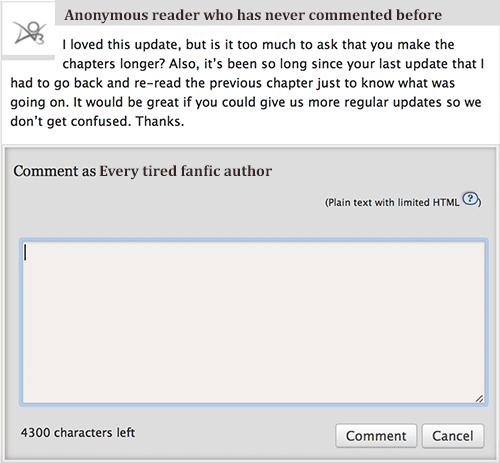
Sources
Reich, J. E. (2015, July 25). Fanspeak: The Brief Origins Of Fanfiction. Retrieved from https://www.techtimes.com/articles/70108/20150723/fan-fiction-star-trek-harry-potter-history-of-fan-fiction-shakespeare-roman-mythology-greek-mythology-sherlock-holmes.htm.
0 notes
Text
Semiotics in The Handmaid’s Tale
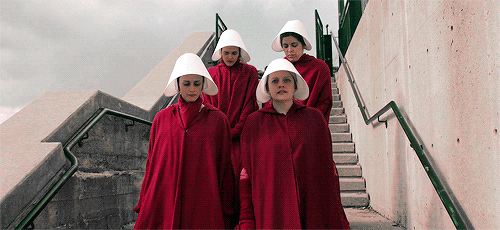
Sign: The Object/Thing

The sign is the outcome or meaning gained from an image, and is also the smallest unit of meaning. Not necessarily an object in this case, but still something is represented. Arguably, in the case of The Handmaid’s Tale, where women are subjected in a patriarchal, male-dominated society, the woman pictured (The Handmaid) is seen as property of her commanding officer, reverting back to a societal era in which women were considered the property of a man. The Handmaid acts as the sign, and her denotation as a handmaid is represented by the plain red dress and white coifs that assist in concealing them from the public view. On the series, Handmaids are recognized by the modest outfit they are forced to wear, which contributes to the signifier and the signified. In order for this “sign” to be defined, we need to be aware of the signifier (any material or physical form of the sign) and the signified (a cultural or social concept that a signifier refers to.
This being said, let’s break down what the Handmaid represents:
Signifier: The physical existence
The word or image represented. The Handmaid is not just a woman dressed in red; the meaning becomes much deeper in the series. Each hierarchical social class of women is categorized by the colours they wear. At the bottom, and most subjected, are the Handmaids and the “Marthas”. While the handmaids wear red, the Marthas wear grey and are assigned to perform household tasks such as cooking and cleaning. Aunts are the women trained to educate the Handmaids on their duty, and often use strict punishments for the Handmaids that rebel. Aunts are categorized by their dark brown plain outfits, usually consisting of a shirt and skirt. Wives are the top of the social class, though still below the society’s men. Wives are women married to high-ranking men with positions in government or law enforcement. Wives are seen wearing fancy, long, blue dresses and having their hair neatly pulled back into a bun.
Focusing again primarily on the Handmaids, the fact that they wear red is not because of a randomly assigned colour. Handmaids in the series are the last remaining fertile women in what was formally America. They live in a dystopian, totalitarian and are subjected into child-bearing slavery. Fertility rates have dropped as the result of sexually transmitted diseases and environmental pollution, and Handmaids are forced to breed healthy children for the most powerful couples helping to stabilize the newly-formed society. All of these factors are the signifiers, the red dresses indicate that they are fertile women and must never be unaccompanied for protection of their “blessed wombs”. The meaning behind wearing red can be explained in the signified.
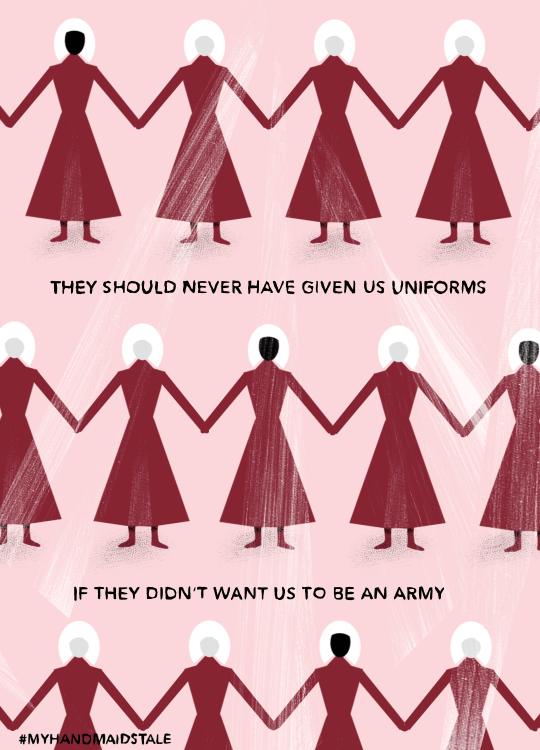
Signified: The mental concept
The concept that is associated with the signifier. The concept regarding the Handmaids is the fact that they are fertile women who have committed sins against the totalitarian society and so they are forced into slavery. According to Margaret Atwood herself, the author of the novel on which the series was based, the red dresses symbolizes fertility. Red represents the blood of the menstrual cycle and the eventual childbirth expected from fertile women. Another meaning is the colour red as a symbol of sexual sin. In The Handmaid’s Tale, fertile women who have been in same-sex relationships, have been divorced, or have committed adultery all become subjected as sexual sinners and therefore must serve as Handmaids to make peace with God. Of course, thinking of the colour red we may think of Nathaniel Hawthorne’s The Scarlet Letter, where adulterous women are also symbolized with the colour red. Either of these explanations for the Handmaid’s dress code acts as the signified. The signified are the deeper meanings to explain the signifier and the sign.

Sources
Atwood, M. (1985). The Handmaid’s Tale. McClelland & Stewart.
Semiotics Explained: Sign Salad. (2018, June 12). Retrieved from https://signsalad.com/our-thoughts/what-is-semiotics/.
1 note
·
View note
Text
Michelle’s Modes of Representation: Dissecting “Friends” from a Viewer’s Perspective
Transparent- Text as Life

Michelle states that audience members have the potential to be active, critical and creative though they are not always so in the same way. Viewers and audiences allow themselves to be completely absorbed by their favourite media texts. In nonfiction programs, such as the news or documentaries, the people and events depicted are assumed to be transparent reflections of an external “real” world. The majority of audience members accept the depictions shown in non-fiction texts as relatively undistorted reflections of reality. With fictional media texts, viewers temporarily suspend their disbelief to allow fictional words the status of “real life”. Michelle emphasizes that the relationship between the tet and viewer in the transparent mode is characterized by closeness or lack of separation, and while viewers are aware that what they are watching is “only a movie”, they allow themselves to become more subjective on an emotional level.
In the case of Friends, one of the six main characters, Chandler Bing, was an on-again off-again smoker throughout the series. The rest of the group obviously despises this awful habit, and another main character, Phoebe Buffay offers Chandler $7000 to quit smoking. While his character remained smoke-free for a majority of the rest of the series, he eventually started up again after a few seasons. This led to concerns in fan-based communities, such as Reddit, where viewers questioned whether Chandler had paid Phoebe back the $7000 after breaking the deal. Several threads on sites such as Reddit and Quora discuss the issue, with several suggestions being offered and the moral dilemma of whether or not Chandler is obligated to give Phoebe her money back because of the binding pact that was drawn. What was never discussed, however, was the simplest explanation- that being that Friends is just a show, and Chandler and Phoebe are fictional characters. Yes, audiences are aware of this fact, but become so submerged into the fictional universe that the ethical dilemma becomes a “real-life” case study debated within the online community.
So, should Chandler have given Phoebe back her money?
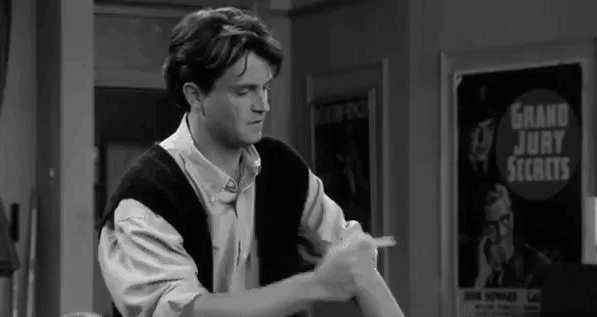
Referential- Text as Like Life
Michelle describes the referential mode as being one step removed from the transparent mode, where viewers perceive the text as standing alongside the real world, making comparisons and analogies between the depicted reality and their own knowledge and experience of the extratextual world. One of these sources of referential information is the viewer’s own personal history or individual biography. Michelle summarizes that viewers are able to draw on their experiences and knowledge of the macro social, political, economic, cultural, national and international context in which they live or which the text produces.
In Friends, one of the most familiar storyline among the audience is quite possibly the famous season 3 breakup of character Ross Geller and Rachel Green. While experiencing a bit of turbulence in their rocky relationship, Ross and Rachel decide to “take a break”, spend some time apart from each other to figure out what they really want, and if they truly want to be together. During this break Ross ends up having a one-night stand with a throwaway character. Rachel understandably reacts out of anger, while Ross justifies the act by stating that they were in fact, on a break. Fans turn to their own experiences and “knowledge of the “macro social and cultural context”, reflecting on how they would react in such a situation. Whether they side with Ross or Rachel depends on their own experiences, and a question that would cause them to lean with the justification of either character could be: Have they ever been cheated on? In this case, they may obviously side with Rachel, as the pain they felt from their partner before causes them to feel a connection with the fictional plot.

Mediated Mode- Text as a Production
Michelle states that the thing that distinguishes the mediated mode of reading is the recognition of the constructed nature of the text as a media production. Mediated readings are characterized by a distinct relationship between text and viewer. Viewers draw on knowledge of aspects of media production, aesthetic ideals, generic conventions and the functions and motivations of the film and television industries. Three subcategories of the mediated mode can be identified, that being the aesthetic focus, the mediated-aesthetic focus and a focus on generic form.
Aesthetic focus- The viewer draws attention to any of various features of technical production such as narrative construction, plot, pace, timing, camera work, editing, scriptwriting, performance or characterization. Friends is often regarded as being a high-brow program, with stellar actors portraying characters unimaginable by any other actor or actress and an abundance of comedic value assisting in marking its spot in history as one of the greatest sitcoms to ever come out of the 90’s. Viewers with this aesthetic focus will center their attention on the minor details, how the plot holds, whether the jokes fall flat and the evaluation of the actors and actresses and their abilities.
Mediated-Aesthetic focus- Reception takes form of a positive or negative evaluation of the quality of such features. Viewers may describe the text using terms such as “moronic”, “boring”, “repetitive” and “corny”. With this focus, viewers may place a heavy focus on the abilities of the scriptwriters. When coming across bland episodes of beloved series, such as the infamous “The One with the Sharks” episode of Friends is widely viewed as being the worst episode of the series, and given its namesake it is fitting that viewers say the series “jumped the shark” with this episode. Reception of the dullness of this episode may be accredited to the fact that this is a late-season episode and writers had simply just run out of fun, new, creative ideas for the groundbreaking series.
Generic Form- Viewers draw on their knowledge of generic conventions- such as narrative formula and characterization particular to genre, or use as interpretive frames of reference texts of the sae genre, other episodes of the same series, or the texts of other genres. Regarding Friends, one may view the characters as stereotypes representative of any other comedic television group. The audience will point out that there’s the spoiled rich girl, the nerd, the basket-case, the attractive popular guy, the comedian and the over-the-top compulsive character. Though original characters for the series, the types themselves are not new and can be seen in other sitcoms with similar plots, such as How I Met Your Mother and The Office.

Discursive Mode- Text as a Message
Michelle states that viewers’ reception framed in the discursive mode specifically address the text’s message, or ideological connotations. The response has two elements: analytical and positional. In the analytical dimension, the viewer identifies the message that is explicitly articulated within the text and analyzes it in terms of motivations or implications. It is only after the message is identified that viewers may express their opinion in response to that particular message.
In Friends, a message that can be identified by the viewer is that life would be dull without the companionship of close friends and the ones you love. The key concept of the show, as suggested by the title, is that the main characters are a group of close individuals who assist each other in everyday dilemmas while also enjoying memorable activities together. Once this message is decoded, it can then be interpreted where they give their response to the particular message. My personal interpretation of the message is overall positive; I can agree that socialization is a key component to a happy lifestyle, though as a huge fan of the series, I also argue that perhaps the emphasis on friendship is too much, and at times the characters on the show become too dependent on each other, as evident in episodes where things go wrong quickly because characters are separated, such as the famous “we were on a break” scenario.

Sources
Michelle, C. (2007). Modes of Reception: A Consolidated Analytical Framework. Communication Review, 10(3), 181–222. https://doi.org/10.1080/10714420701528057
1 note
·
View note
Text
Maslow’s Social Media Hierarchy: Applying my Social Media Use to Maslow’s Hierarchy of Needs.

At the bottom of the pyramid…
Physiological needs
Our most basic of needs, according to American psychologist, Abraham Maslow are what as defined as the biological necessities for human survival, including air, food, water, shelter, warmth and sleep. When applying these needs to my own social media usage, I recognize that I have fulfilled this step already. Yet, it is important to remind ourselves that our usage of social media cannot depend on “physiological needs” alone. Before being able to properly navigate the majority of social media sites, you must first have an account on that site. This is the most basic need of media fulfillment. Simply creating a social media account is the bare minimum, though you can still “survive” on an account with zero followers and no posts. The account may not be entirely beneficial in your overall plan to utilize social media, but you can still simply get by. Most of my social media accounts were created several years ago, and I consider myself to have progressed from this stage. Though I realize there are many sites and applications out there that I have not invested any time in, and if I felt like starting a new chapter on the newest social media platform, I would once again find myself at the bottom of Maslow’s pyramid, attempting to fulfill these “physiological” media needs.

Safety Needs
The next step up the pyramid and still basic needs that ensure human survival, protection from harsh elements, security, order, law and stability are examples provided by Maslow. After creating an account, the first step in your social media career, your next concern is online safety. Not only do we need to feel safe physically, but digitally as well. Social media, and the internet as a whole, can cause insecurities in safety. With the increased amount of internet spam, trolls, and hackers, we can find ourselves having a difficult time establishing our safety needs on social media. Our goal in this step is to be able to express ourselves freely and safety without fear of repercussions. While examining my own social media usage, I believe I have conquered most of the fears I face regarding cyber security, but new fears often arrive. As of now, I consider my online identity to be beyond this step of the pyramid, but still bear in mind how easy it is to fall backwards when new threats arise. I ensure my security by privatizing my accounts, so that only my closest of friends can interact with my online-self. All of my accounts are password-protected and I educate myself on knowing what safe websites look like, making sure to never visit a potentially unsecure environment.
Love and Belongingness

Moving up towards the middle of the pyramid, and after physiological and safety needs are met, Maslow suggests the need for interpersonal relationships including, friendship, intimacy, trust, acceptance and affection. While logging into the online world, it is still vital to feel a sense of belonging among social groups, even if these are not physical, face-to-face interactions. This sense of belonging can stem from social media aspects such as Facebook messenger, Instagram stories and Snapchat group chats. I have a sense of social belonging online, and would confidently declare that I have achieved this step of the pyramid. I am in several group chats on different platforms, including Facebook and Snapchat, with some involving co-workers, classmates and family members. I never come down with a sense of loneliness online, and often escape to a digital world when I feel as if I have no one else to talk to in a physical state.

Esteem Needs
Maslow described the need for respect and reputation being important, especially in the developmental stages of childhood and adolescence. He described that not only do we require esteem for ourselves, but also desire respect from others. To describe this step, the terms respect, self-esteem, status, recognition, strength, and freedom apply to the needs at this level. I am surely not the only one who concerns myself with the matters of recognition, importance and status. Online, we post things expecting a certain amount of respect in return. I show my “best self” on social media, always ensuring my photos are flattering and my statuses are error-free in terms of grammar. In turn, I gain happiness from the positive attention that stems from showing my best self. I expect an abundance of likes and comments on the content I share, and my self-esteem is fulfilled when this is met. However, I would not declare that I have successfully passed this step of the pyramid, as there is the issue of not showing my true self. I present social media with an almost fictionalized version of myself that I believe will gain appreciation. I edit out the pimples, double chins and makeup malfunctions in the pictures I post. I am only gaining esteem from the person I want to be, not from the person I am.

At the top of the pyramid…
Self-Actualization
The very last step in the pyramid, which not everyone reaches. All other needs in the pyramid must be met before meeting the ability to achieve one’s full potential. As Maslow states, “A desire to become everything one is capable of becoming” (Maslow, 1987). Achieving self-actualization on social media can be described as having achieved the ideal social media profile, or online identity, something that I definitely not have met, and would argue that no one has met. I would consider self-actualization on social media to be an impossible feat, as no one is free from the potential dangerous “hate” online. For an average consumer, self-actualization can be having a Facebook profile filled with posts that only solicit positive reactions, while to a higher-status individual; self-actualization may be the verification of their status on platforms such as Twitter and Instagram. While these can both be easily achieved, it is still easy to be knocked back down as soon as we summit that pyramid. Even with 100% positive feedback, and a verification of you as an important figure, there is still the opportunity for judgement. Though we may reach self-actualization with some aspects of our online identity, our online existence can never meet this, no matter how many likes we receive, there is always a chance to be kicked back down.

Sources
Asher, N. (2014). Maslow’s Hierarchy Of Needs In Social Media. Retrieved January 29, 2016, from http://roarlocal.com/maslows-hierarchy-social-media/
Mcleod, S. (2018, May 21). Maslow’s Hierarchy of Needs. Retrieved from https://www.simplypsychology.org/maslow.html.
Sullivan, J. (2013). Media Audiences: Effects, users, institutions and power (1st ed.). (pp. 115-118) Sage Publications Inc., New York, NY.
1 note
·
View note
Text
Netflix Sees Their Audience As Objects... Here’s Why.

Now that the fall has rolled around, Netflix has been continuously providing us with new shows, movies and additional seasons to the series we are already invested in. Logging onto Netflix recently caught my attention, as I began to see the streaming application in a different light. No longer do I see the popular site as just a place for me to binge on my favourite shows while letting out the stress after a three-hour lecture on the history of silent cinema, but I have been beginning to see Netflix as an application notorious for one thing- target marketing. I used to view the shows the site suggested for me as beneficial for my particular viewing habits, and never really thought much of the practice until recently. Now, logging in with the abundance of Halloween specials all I can imagine are the algorithms the developers have set out to keep me invested in their service. Does Netflix really value me as a customer, or am I just another number? I can justify my thought of myself and the millions included in the Netflix audience as simply objects, using a five-question approach.

What if our “choices” (as a result of target marketing – and as indicated by media ratings) are not really choices?
Netflix surprises me with what they suggest, especially when considering the fact that whether I am using my profile on my mother’s account, or the profile on my father’s account, where I essentially watch the exact same programs, I always receive obscure suggestions that I somehow always end up watching, whether or not they coincide with the programs I have viewed. I enjoy watching raunchy comedies, and my viewing history makes this clear as I constantly re-watch shows such as Family Guy and films such as Superbad and Pineapple Express. However, when my suggestions include sappy, romantic, holiday films such as A Christmas Prince, and I choose to watch it, no matter how much I hate myself after, I begin to argue whether or not I actually did choose to watch the program. Of course, physically I did select that specific film to watch while at home on a Friday evening as opposed to the hundreds of raunchy comedies available to me. Aside from my physical decision, I would argue that in some ways, I did not have a choice and that Netflix has an almost sadistic way of pulling viewers into the original series they want us to engage with. I did not watch A Christmas Prince because I was interested in it, but I feel like with the publicity the film received, to the point where official Netflix accounts were essentially making fun of the viewers who watched the film every single day was what caused me to view the film. I did not choose A Christmas Prince, Netflix chose it for me with their genius marketing tactics and way of making us feel obligated to jump on the viewing bandwagon.
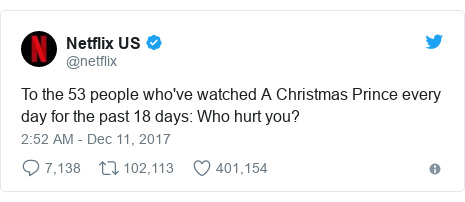
What if we’re doing all the work?
With this question, I feel somewhat neutral towards the answer. I do feel as if we are unconsciously doing work when watching Netflix, but I consider most of the time I spend binge-watching as a form of leisure. Watching my favourite Netflix programs becomes a stress-reliever for me, where I can sit back, under the covers while watching shows or movies that I enjoy. Occasionally, I can multi-task while watching familiar shows where I am not afraid to miss certain scenes as I have already seen the episode a dozen times. I can finish my homework, clean my room or cook dinner all while continuing to let Netflix play in the background. In this sense, I do not consider to be doing work because watching television helps me to relax and unwind after a long day. If anything, I would consider watching Netflix to be the opposite of work, yet unconsciously there can be an argument that we are doing work for the bigger picture. Netflix chooses programs carefully based on viewer reception, and without the work from us, the audience, how could Netflix possibly know what shows their demographics want to see on their website? Perhaps we are doing a tremendous amount of work with minimal effort. Audiences as objects are the key component to keeping Netflix thriving on success. Without an audience to collect and interpret data, influencing their overall marketing schemes, the company would arguably face a decline in the overall satisfaction rates gained from viewers excited to see that a new season of their favourite show has been added, based on popular demand.
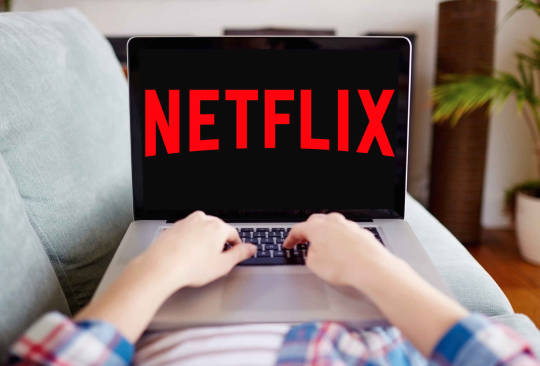
What if ratings and marketing have turned us into data?
After investigating the help section of the official Netflix website, I stumbled across an illustration of how the site’s recommendation section actually works. Netflix studies several patterns connected with our viewing. They monitor our viewing history as well as the history of other members with similar habits, and information on the shows themselves such as the actors, directors and year released. Additionally, the site monitors the time of day we tend to watch Netflix, what device we choose to watch on and for how long we watch in a single viewing period. All of this data is input into Netflix’s complex algorithms which output a design that satisfies a personalized viewing experience. After reading this, I strongly stand by my argument that we are seen as “objects” to the big-wigs over at the Netflix headquarters. Though the site claims to be creating an enjoyable experience for us, specifically, I doubt the programs on my recommendation list differ that much from other users. Even after comparing suggested titles on my account versus my mother’s account, it is clear that despite the different tastes we both have, we both feel forced into engaging with whatever Netflix original is trending based on what “everyone is watching”. Computers pumping out numbers, almost like a dating site, matchmaking me with programs the bots think I’ll enjoy does not feel personal to me.

What if ratings and marketing have made us unhappy?
After reading an article titled, Unhappy Endings, published by the site “Medium”, where the unsatisfactory ending to Game of Thrones is explored, I can argue that when studying popular opinion, sometimes ratings and marketing can make us unhappy. As much as I attempt to avoid spoilers regarding the program I am currently watching, sometimes it is inevitable as I log on for my daily morning browse of Reddit or Twitter. When I hear the negative discussions surrounding a film’s release, or a series’ end, I find it difficult to return back to that show or continue with my plans to see that movie. Why bother seeing a film if the general consensus has been negative? Surely, it will not be interpreted different by me, right? These are the questions that fill my mind, causing me unhappiness when I know deep down that I will be disappointed by something I had anticipated, or previously enjoyed. Ratings can make us unhappy, when studied in this specific scenario- no matter how much we love a director, or actor, or genre, when we see that low audience rating on whatever film Netflix is trying to pitch, do we continue with our plans to watch the program? I certainly do not, as a negative mindset heavily impacts my actions and opinions. This is yet another way of viewing Netflix customers as objects, as once again the notion of “jumping on the bandwagon” takes place. If everyone else is boycotting this film, or calling it an utter piece of trash, why bother engaging?

What if ratings and marketing have made the planet unhealthy?
Perhaps, after examining the above questions, our final argument can be that ratings and marketing can have an effect on the planet as a whole, and provide the global audience with unhealthy standards. We know that generally, television viewing is an unhealthy habit and one that should be done in moderation. With the rise of Netflix, and the site’s marketing techniques, this activity has evolved beyond moderation and has blown up into an ongoing event. Speaking from personal experience, I would estimate that I watch at least 5-6 hours of television in a single day, which is a drastic amount compared to the fact that I should be sleeping at least 8 hours, attending school for 6 hours a day on average and studying at least another 3-4 hours each evening. Yet, Netflix has pulled me in and kept me hooked, like a dealer and his addict. I keep returning to Netflix when I hear people discussing the addition of new seasons of my favourite programs, and I always feel obligated to check out the buzz over whatever newest Netflix original is published. As I said earlier, sometimes I feel I lack freedom in choosing when I watch and what I watch on the app. I know how unhealthy a solidary lifestyle can be, yet I and millions of others who have fallen into the Netflix trap continue to go back for more. Netflix, and other streaming platforms, are addictive and have only added to the dangerous pattern of bingeing behaviour that humans have been known to partake in. Netflix views their customers as objects, and thrive on the publicity and financial support we provide, yet several, including myself, have failed to recognize the dangers held in simply being just one single number in a pool of millions.
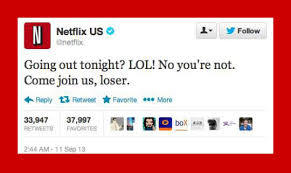
Sources
Ballard, C. (2019, July 16). Unhappy Endings. Retrieved from https://towardsdatascience.com/unhappy-endings-36e5fd157703.
How Netflix’s Recommendations System Works. (n.d.). Retrieved from https://help.netflix.com/en/node/100639.
1 note
·
View note
Text
Agenda-Setting Theory and Royal Wedding Coverage

The media has a strong effect on what we think about, creating senses of urgency regarding topics that do not always reflect reality. The media chooses to highlight certain events in a way that we perceive this constructed reality as important events pertaining to societal issues. McCombs and Shaw (1972) developed the “agenda setting theory”, which suggests that media has a great influence on audiences by instilling what they should think. News items the media chooses to cover prominently will be the issues audiences regard as most important. With agenda setting theory, it is proclaimed that the media does not reflect reality, but rather filter and shape it in a way they see fit. The history of British royal weddings, especially in recent times, such as the weddings of Prince William to Kate Middleton and Prince Harry to actress Meghan Markle completely captivated the attention of the world, even parts of the world with no connection to the British monarchy. Audiences may question why the wedding of two people, who have no relation or personal connection to them, is so important that the event receives global coverage and media attention.

In the United Kingdom, most royal weddings are designated public holidays. In commonwealth countries, including Canada, several organizations host events to mark the big occasion. The wedding of Prince William and Kate Middleton gained an outstanding amount of media coverage and audience engagement. In addition to the millions of people crammed between Westminster Abbey and Buckingham Palace, the ceremony itself was viewed live by tens of millions people around the world, with an additional 72 million live streams on YouTube. The wedding was broadcast on several media platforms including television, internet and radio coverage in over 180 countries. Excluding the United Kingdom, an estimated 60 million U.S. viewers tuned in, 42.1 million viewers from India, 9.9 million from Germany, 9.6 million from France, 5 million from Australia and 12 million from Canada. Approximately 45% of the world’s population tuned in to watch the event. The 101 million streams on YouTube became listed in the 2012 Guinness Book of World Records for “most live streams for a single event”, beating out its previous holder, the Michael Jackson memorial service in 2009.

I do remember the hype for the royal wedding of Kate and Will from the perspective of a 14-year-old living in southern Ontario. Despite not being overly active on social media at the time, I do remember my Facebook and Twitter feeds being flooded with news about the engagement, the build-up and then eventually the wedding. Thinking back to the spring of 2011, I cannot seem to remember any other events being covered. After conducting some research, I did manage to find some major events that had occurred that I am also ashamed to admit I do not remember. A quick skim through Wikipedia’s current events portal of April of 2011 informed me of natural disasters, record unemployment numbers, protests, acts of war, scientific discoveries and murders that I had not been aware of at the time. I would expect that coverage of the 2011 Libyan war and Syrian protests would be at the top of every newsfeed, as these are legitimate global issues, but agenda setting once again distorts reality and silences the topics that can render us vulnerable. The media agenda tends to focus on the famous and rich, sensationalism in the news as opposed to the morbidity of the global issues we should be aware of.

Arguably, with Prince William being a direct heir to the British throne and the future King of England, his wedding was a big event, though maybe still excessive in terms of media coverage. When William’s younger brother, Harry became engaged to American actress Meghan Markle, the media acted on this sensationalism once again, flooding the news with stories and gossip regarding the unlikely couple. With Harry being the younger brother of William, and thus sixth in line for the throne of England, one would not think his wedding would be as big a deal compared to that of his older brother, the legitimate heir. However, with the proof given with the previous wedding that the media prefers the sappy, romantic gossip-fueled nuptials of a prince with almost a zero percent chance of ever inheriting the throne and the B-list actress of a mediocrely popular show.

Once again delving into the Wikipedia portal of the events that transpired in May of 2018, the same month Harry and Meghan tied the knot, I attempted to find any events that I was even slightly aware of at the time of the wedding. Not once during the build-up to the big day, and even in the months following did I hear of the Boko Haram suicide bombing that killed 24 people in a Nigerian mosque, or the resignation of Louisiana Secretary of State, Tom Schedler, following sexual abuse allegations. The only topic I was familiar with was Ashley Judd’s lawsuit against Harvey Weinstein for defamation and sexual harassment, but this does not surprise me. The Harvey Weinstein allegations were a major source of coverage in the media, especially as several famous American actresses came forward against the perpetrator, once again suggesting that the media agenda cares much more for Hollywood buzz than morbid global topics. Of course, the Weinstein assaults are a relevant topic to cover, but it was generally trumped by the May 19th event, and the questions regarding the designer of the Duchess’ dress, the amount of guests in attendance and who would ultimately walk Meghan down the aisle following the drama revolving her father selling private wedding information to the press. According to agenda setting theory, audiences should be much more aware of these elegant, worthy topics over the global crises that will cause us legitimate fear and worry for our society.

Sources
“2 billion tune in to Royal Wedding”. News.com.au. News Limited. 1 May 2011. Retrieved 15 July 2011.
April 2011. (2015, December 12). Retrieved from https://en.wikipedia.org/wiki/Portal: Current_events/April_2011.
Holden, Michael (2 April 2011). “UK minister says 2 billion to watch royal wedding”. Reuters. Retrieved 15 July 2011.
Itzel Cruz Monroy (2014, March 28). The Royal Wedding and the Agenda Setting. Retrieved from https://strategicommunication12.wordpress.com/2014/03/28/the-royal-wedding-and-the-agenda-setting/
May 2018. (2018, June 17). Retrieved from https://en.wikipedia.org/wiki/Portal:Current_events/May_2018.
“Royal Wedding Watched by 24.5 Million on Terrestrial TV.” BBC. 30 April 2011.
Team, T. (2014, February 28). Retrieved from https://opentextbc.ca/mediastudies101/chapter/agenda-setting/
Winnett, Robert; Samuel, Henry (30 April 2011). “Royal wedding watched around the world”. The Daily Telegraph. Retrieved July 15 2011.
1 note
·
View note
Text
Marvel “Stans” and Brown’s Four Processes of Audience Involvement

“Only the most pop culturally isolated English speakers don’t know what the word “stan” means. Its origins lie in Eminem’s 2000 hit song “Stan,” about an overzealous fan, and has come to describe anyone who takes their love of a particular artist or entertainment franchise to new extremes” States Ann-Derrick Gaillot in her article, “When ‘Stan’ Became a Verb”. The term now floats around in several fan-based communities, or fandoms, for short. The Marvel Cinematic Universe has made such a great impact on pop culture with their transmedia storytelling through films, comics, and television series. Outside of the “canon” content comes the realm of fans, producing fanwork, fanart, and social media accounts dedicated to their beloved characters. On the extreme end of this practice are the engaged super-fans, or “Stans”, a term that goes beyond the simple use of “fan”. William J. Brown describes four processes of audience involvement that, when examined, can explain the practices of these Marvel Stans, and why they become so involved in this fantasy world.
Transportation
“A highly transported individual is cognitively and emotionally involved in the story” (Green, 2004), engaging in transportation described not only one’s involvement in a story, but also with the characters of a story. Green and Brown continue to describe the suggestion of “transportation into a narrative world” to describe the immersion of audiences, or how self-proclaimed Stans can become lost in a story. Transported individuals can identify with the characters, and some take this to the extreme, as evident with fanfiction self-inserts. This type of storytelling involves the author as the character itself, and several works of this genre can be found on popular sites such as Wattpad and Archive of our Own. This act exemplifies the definition of transportation, as the author is not only delving into the fictional world, but becoming involved as a character themselves. They interact with the characters, become situated in familiar, fictional, environments while establishing their own creative narrative. Individuals become cognitively and emotionally involved in the story, especially as they write from their own perspectives. Stans feel like they belong in these stories, and go to the extreme of inserting themselves into the already established events as seen in canon fandom media types.

Parasocial Interaction
“A decade after Merton’s study was published; Horton and Wohl (1956) published their seminal study of PSI. They described PSI as imaginary interaction between a television viewer and a television personality, which over time may develop into a self-defined one-way relationship called a parasocial relationship.” (Horton & Wohl, 1956) The study of parasocial interactions comes from a psychological perspective and focuses on how media personae can influence the development of an adolescents’ self-concept. People can form imaginary relationships with media personae through the consumption of media texts. Marvel Stans once again prove themselves to be an ideal example of participants in parasocial interaction, as evident by social media. Occasionally it is hard to determine whether these young enthusiasts really do think they are in romantic relationships with the characters and the actors who portray them. I am ashamed to admit that as a previous super fan back in my blunder-years, I participated in this almost creepy form of parasocial interaction, where my friends and I would create Facebook accounts for fictional characters and interact with them as if they were live, legitimate accounts.

Identification
“Kelman conceptualized identification as a process of social influence. He believed identification involves the internalization of the attitudes, beliefs and values of the object of identification by the person who is being influenced. Identification occurs from this perspective when an individual adopts the attitudes, values, beliefs or behavior of another individual or group based on a ‘self-defining’ relationship” (Kelman, 1961, p. 63). It is not uncommon for Stans to internalize the attitudes, values and beliefs as they desire the connection it provides. People can identify with media personae without any face-to-face interaction due to the adoption of behaviours. Marvel consumers can take the perspectives of the media personas they follow. Cosplayers and roleplayers use identification as a form of pleasure, they can dress up like and adopt the mannerisms of those they see on the big-screen. The practice of identification can also meet extreme ends, and as Brown mentions, sometimes in identification, one needs to forget themselves in order to become the other. If you have ever been to a major event such as Comic Con, then you are familiar with the extremes that some of these cosplayers will go to; refusing to break character, spending hundreds of dollars on costume accessories and some even extending their practice beyond the event itself, and adopting an online persona of the characters they play. Remaining in character, or identifying, shifts from being a full-time job, to a lifestyle choice.

Worship

“The most recently conceptualized and most intense form of involvement with media personae is identified as worship. Focusing on audience involvement with celebrities, John Maltby and his colleagues have explored how media consumers tend to idolize celebrity personae, even to degree that they consider such involvement to emulate worship” (Maltby et al, 2004). Stan accounts are probably the most prevalent example of celebrity worship, with some of these fans displaying religious, even cult-like attitudes towards the actors who play these characters they adore. As Brown states in his article, celebrities are sometimes given the attention and status normally given to a deity. We hear examples of over-the-top fans who worship to the point where they would kill for their idols. Thankfully, in my research I have come across no such extremes with the marvel fanatics. Three levels of worship are described in Brown’s reading with the low-levels including simple acts such as following the lives of celebrities, talking about them and finding others who share the same feelings of their favourite stars. This is evident all over the social media realm, with Stan accounts following the verified accounts of the ones they worship, retweeting and following who they follow. The medium and high levels of celebrity worship start to take on a more intense role, and become what is described as slightly pathological. Higher levels of celebrity worship can be abnormal and harmful, and this accounts for fans that go to the extreme of stalking their idols and threatening the ones who come close to the ones they love. This picture portraying Marvel character Bucky Barnes as Jesus Christ is obviously satirical, but sometimes not far from the way some fans view the people they worship.

Sources
Brown, W. (2015). Examining four processes of audience involvement with media personae: Transportation, parasocial interaction, identification, and worship. Communication Theory, 25, 259-283.
Gaillot, A.-D. (2017, October 26). When "stan" became a verb. Retrieved from https://theoutline.com/post/2425/when-stan-became-a-verb?zd=2&zi=5uphh3mk.
5 notes
·
View notes
Text
Morbid Curiosity and the History of the Audience
The Execution of Charles I
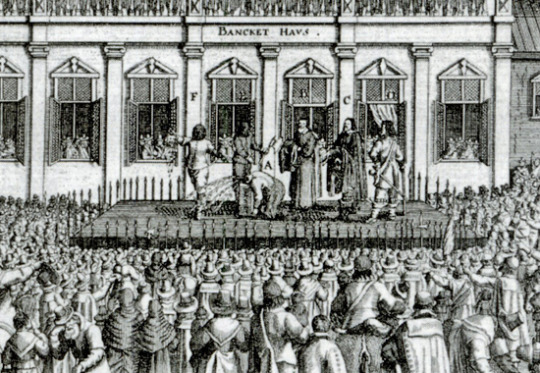
Charles I was King of England, Scotland and Ireland from March of 1625 until his execution in January of 1649. Due to his belief in the Divine Right of Kings, Charles’ rule was filled with quarrel with the English Parliament. In 1642, Charles fought in the English Civil War, was defeated and refused to accept the demands of a constitutional monarchy from his captors. As a result, Charles was tried and convicted for high treason, eventually to be sentenced to a public beheading. In Graham Edwards’ The Last Days of Charles I, he claimed that it was common practice for the severed heads of traitors to be held up and exhibited to the crowd, which did happen in the case of Charles. In a description of his execution, the former King was said to have been led by guards to a scaffold erected in front of the banquet house, where a crowd of spectators were separated by the soldiers in attendance (Carlton, 1995). During the Middle Ages public torture and execution was common, often being regarded as an acceptable form of punishment. The nature and severity of the crime suggested the amount of pain inflicted on the offender. There were few rights given to prisoners, and executions became a widespread, unregulated event attended by large, jeering crowds despite the gruesome nature (History TV, n.d.).
Morbid Curiosity? Why tune into such a gruesome act?
Of course, it’s evident that forms of entertainment in the medieval era are slimmer than what we are presented with today. There was no television, no movies, and lower literacy rates, so what else to do then go out and witness the beheading of your current monarch? Can we actually attribute the large crowds of spectators to the fact that there was just simply, “nothing else to do”, or can we interpret this audience behaviour from a different perspective? Perhaps, we can study the topic of morbid curiosity, a term defined as “an aspect of curiosity that be seen as focused on objects of death and/or violence.” The term is not new, and dates back to Aristotle who states, “[We] enjoy contemplating the most precise images of things whose sight is painful to us.”

From the Middle Ages to Today’s Society
Though accounts from medieval audiences may be hard to cite, we can understand that these early forms of audiences were the beginning stages in the same type of fascination we have today. Our understanding of early audiences would describe events such as an execution, especially one of such a high status figure as Charles I, as organized and planned, collocated in time and space, and roles of authors, performers and spectators being outlined and defined. Of course the performers in this sense taking on a sadistic meaning, with the executioner and the traitor both playing huge, yet presumably unwanted, roles. Thanks to the expansion of technology, unmediated, or smaller, audiences have shifted to mediated ones. From thousands co-located in space to millions around the world co-located in time.
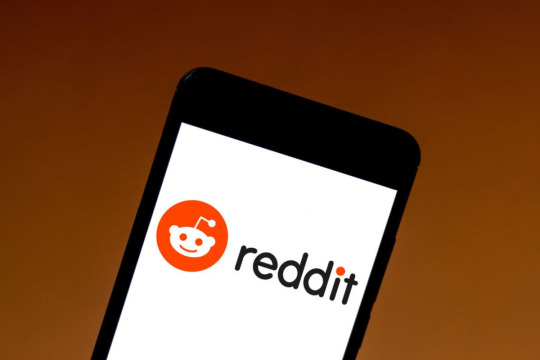
Reddit, a site often popular for some of the controversial content posted, and subreddits such as r/MorbidCuriosity, r/WatchPeopleDie, r/5050 and r/Gore, as the titles suggest, focus heavily, if not entirely on subjects that the morbidly curious would be drawn to. This curiosity itself of these gruesome, often despicable acts may have not changed, as it is apparent that this has been a form of entertainment for thousands of years. Yet, the accessibility has increased with the shift of small to large, digital audiences. Have our motivations for witnessing these events changed? I would argue not, as even these early audiences had choice in whether they should consume such frightful scenes, as we now have choice with other forms of entertainment provided to us. We can simply say that human curiosity and the accumulation of audience viewership have not changed. Morbid curiosity is a decades-old source of entertainment, where audience’s fulfillment of the subject has only been heightened in the wake of the digital era.
As Eric G. Wilson, a Professor of English at Wake Forest University describes,
"The morbidity of sorrow is often a productive sluggishness, a time when the soul slows down, too weary to go on, and takes stock of where it's been and where it's going. During these gloomy pauses, we often discover parts of ourselves we never knew we possessed, talents that, properly activated, enrich our lives.
Sources
Carlton, Charles (1995), Charles I: The Personal Monarch (Second ed.), London: Routledge
Edwards, Graham (1999), The Last Days of Charles I, Stroud: Sutton Publishing
Neal, K. (2013, January 3). Beauty has a dark side. Retrieved from https://news.wfu.edu/2012/02/28/beauty-has-a-dark-side/
Take a look at some of the execution methods of the past (n.d.). Retrieved from https://www.history.co.uk/shows/britains-bloodiest-dynasty/articles/execution-in-the-middle-ages.
2 notes
·
View notes
